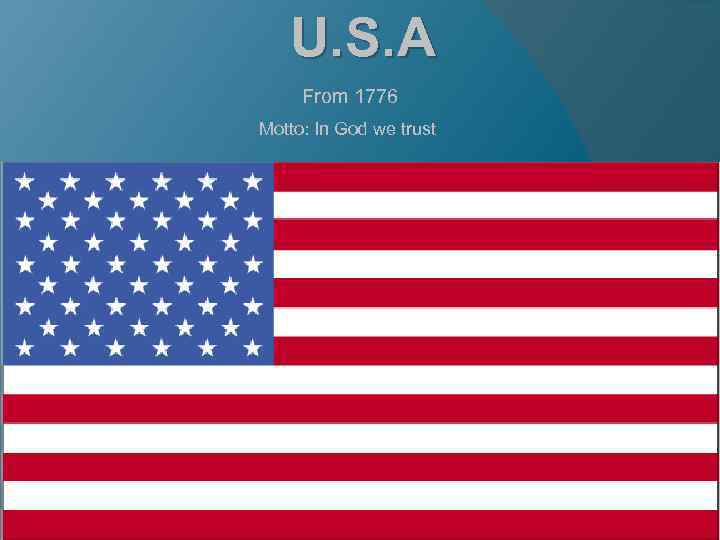 U. S. A From 1776 Motto: In God we trust
U. S. A From 1776 Motto: In God we trust
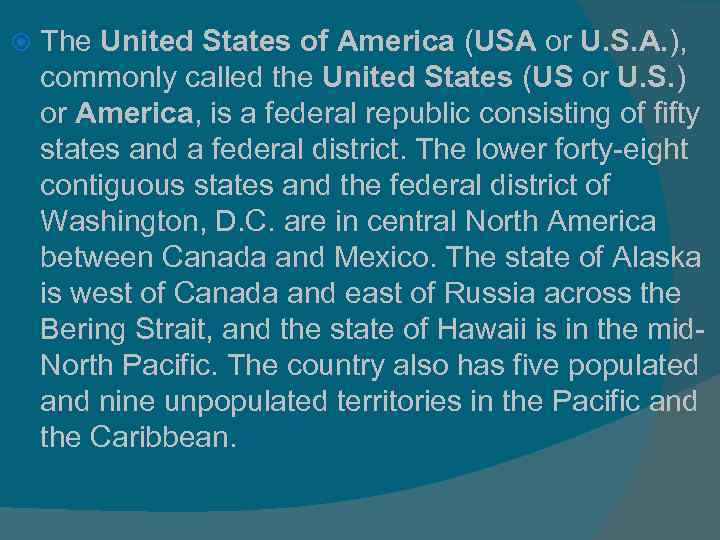 The United States of America (USA or U. S. A. ), commonly called the United States (US or U. S. ) or America, is a federal republic consisting of fifty states and a federal district. The lower forty-eight contiguous states and the federal district of Washington, D. C. are in central North America between Canada and Mexico. The state of Alaska is west of Canada and east of Russia across the Bering Strait, and the state of Hawaii is in the mid. North Pacific. The country also has five populated and nine unpopulated territories in the Pacific and the Caribbean.
The United States of America (USA or U. S. A. ), commonly called the United States (US or U. S. ) or America, is a federal republic consisting of fifty states and a federal district. The lower forty-eight contiguous states and the federal district of Washington, D. C. are in central North America between Canada and Mexico. The state of Alaska is west of Canada and east of Russia across the Bering Strait, and the state of Hawaii is in the mid. North Pacific. The country also has five populated and nine unpopulated territories in the Pacific and the Caribbean.
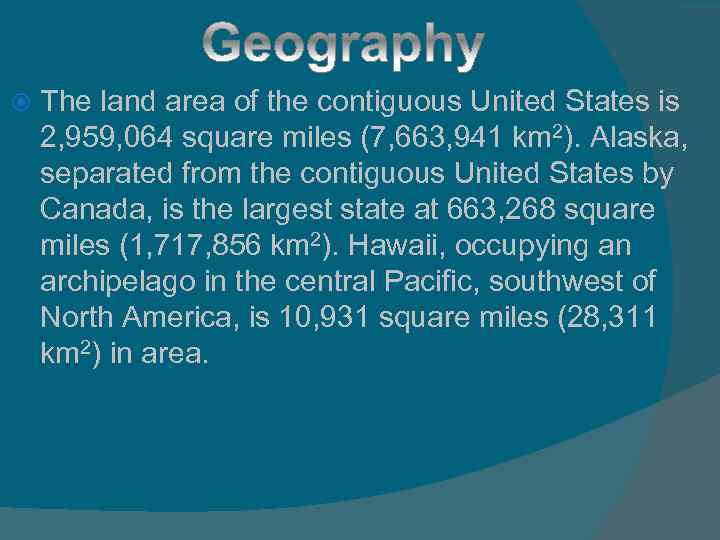 The land area of the contiguous United States is 2, 959, 064 square miles (7, 663, 941 km 2). Alaska, separated from the contiguous United States by Canada, is the largest state at 663, 268 square miles (1, 717, 856 km 2). Hawaii, occupying an archipelago in the central Pacific, southwest of North America, is 10, 931 square miles (28, 311 km 2) in area.
The land area of the contiguous United States is 2, 959, 064 square miles (7, 663, 941 km 2). Alaska, separated from the contiguous United States by Canada, is the largest state at 663, 268 square miles (1, 717, 856 km 2). Hawaii, occupying an archipelago in the central Pacific, southwest of North America, is 10, 931 square miles (28, 311 km 2) in area.
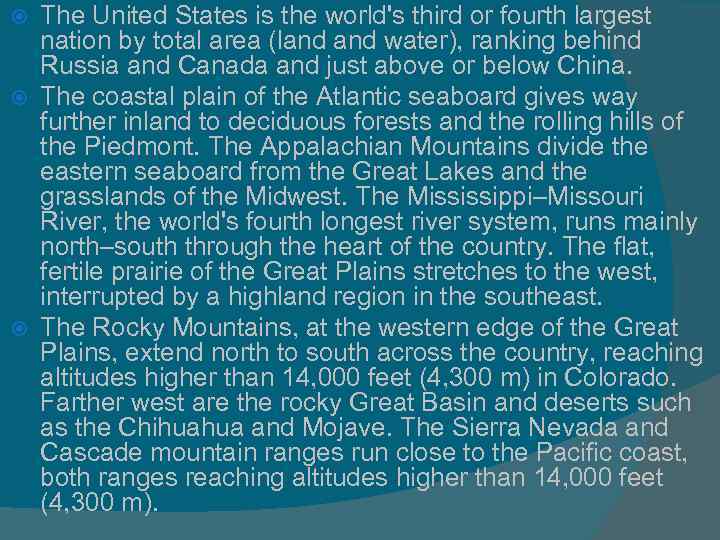 The United States is the world's third or fourth largest nation by total area (land water), ranking behind Russia and Canada and just above or below China. The coastal plain of the Atlantic seaboard gives way further inland to deciduous forests and the rolling hills of the Piedmont. The Appalachian Mountains divide the eastern seaboard from the Great Lakes and the grasslands of the Midwest. The Mississippi–Missouri River, the world's fourth longest river system, runs mainly north–south through the heart of the country. The flat, fertile prairie of the Great Plains stretches to the west, interrupted by a highland region in the southeast. The Rocky Mountains, at the western edge of the Great Plains, extend north to south across the country, reaching altitudes higher than 14, 000 feet (4, 300 m) in Colorado. Farther west are the rocky Great Basin and deserts such as the Chihuahua and Mojave. The Sierra Nevada and Cascade mountain ranges run close to the Pacific coast, both ranges reaching altitudes higher than 14, 000 feet (4, 300 m).
The United States is the world's third or fourth largest nation by total area (land water), ranking behind Russia and Canada and just above or below China. The coastal plain of the Atlantic seaboard gives way further inland to deciduous forests and the rolling hills of the Piedmont. The Appalachian Mountains divide the eastern seaboard from the Great Lakes and the grasslands of the Midwest. The Mississippi–Missouri River, the world's fourth longest river system, runs mainly north–south through the heart of the country. The flat, fertile prairie of the Great Plains stretches to the west, interrupted by a highland region in the southeast. The Rocky Mountains, at the western edge of the Great Plains, extend north to south across the country, reaching altitudes higher than 14, 000 feet (4, 300 m) in Colorado. Farther west are the rocky Great Basin and deserts such as the Chihuahua and Mojave. The Sierra Nevada and Cascade mountain ranges run close to the Pacific coast, both ranges reaching altitudes higher than 14, 000 feet (4, 300 m).
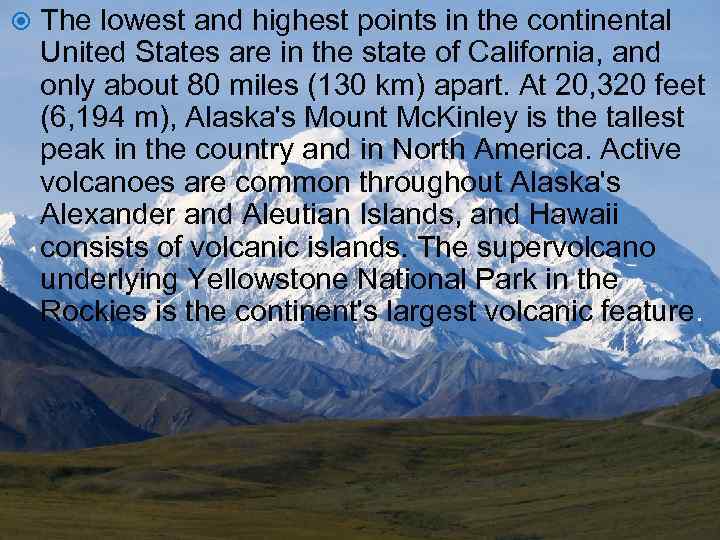 The lowest and highest points in the continental United States are in the state of California, and only about 80 miles (130 km) apart. At 20, 320 feet (6, 194 m), Alaska's Mount Mc. Kinley is the tallest peak in the country and in North America. Active volcanoes are common throughout Alaska's Alexander and Aleutian Islands, and Hawaii consists of volcanic islands. The supervolcano underlying Yellowstone National Park in the Rockies is the continent's largest volcanic feature.
The lowest and highest points in the continental United States are in the state of California, and only about 80 miles (130 km) apart. At 20, 320 feet (6, 194 m), Alaska's Mount Mc. Kinley is the tallest peak in the country and in North America. Active volcanoes are common throughout Alaska's Alexander and Aleutian Islands, and Hawaii consists of volcanic islands. The supervolcano underlying Yellowstone National Park in the Rockies is the continent's largest volcanic feature.
 Mississippi River
Mississippi River
 Desert Chihuahua
Desert Chihuahua
 The first Spanish explorers landed in "La Florida" in 1513. Spain set up settlements in California, Florida, and New Mexico that were eventually merged into the United States. There were also some French settlements along the Mississippi River. The English settlements up and down the Atlantic coast were by far the most important in shaping the history of the United States. The Virginia Colony began 1607 and the Pilgrims' Plymouth Colony in 1620. In the French and Indian War, British forces seized Canada from the French, but the francophone population remained politically isolated from the southern colonies. Excluding the Native Americans, who were being displaced, those thirteen colonies had a population of 2. 6 million in 1770, about one-third that of Britain. Nearly onefifth of those living in what would become the United States were black slaves.
The first Spanish explorers landed in "La Florida" in 1513. Spain set up settlements in California, Florida, and New Mexico that were eventually merged into the United States. There were also some French settlements along the Mississippi River. The English settlements up and down the Atlantic coast were by far the most important in shaping the history of the United States. The Virginia Colony began 1607 and the Pilgrims' Plymouth Colony in 1620. In the French and Indian War, British forces seized Canada from the French, but the francophone population remained politically isolated from the southern colonies. Excluding the Native Americans, who were being displaced, those thirteen colonies had a population of 2. 6 million in 1770, about one-third that of Britain. Nearly onefifth of those living in what would become the United States were black slaves.
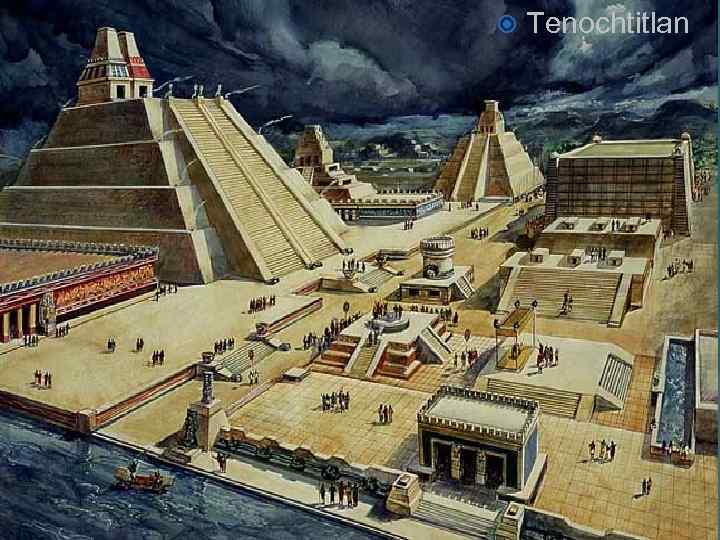 Tenochtitlan
Tenochtitlan
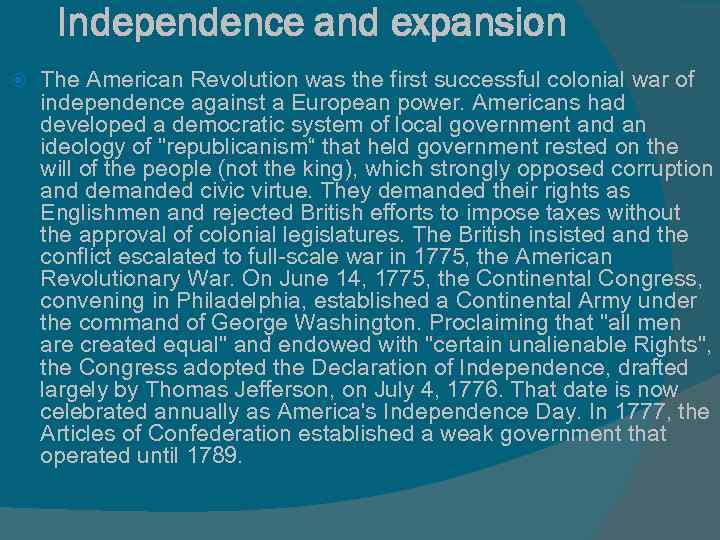 Independence and expansion The American Revolution was the first successful colonial war of independence against a European power. Americans had developed a democratic system of local government and an ideology of "republicanism“ that held government rested on the will of the people (not the king), which strongly opposed corruption and demanded civic virtue. They demanded their rights as Englishmen and rejected British efforts to impose taxes without the approval of colonial legislatures. The British insisted and the conflict escalated to full-scale war in 1775, the American Revolutionary War. On June 14, 1775, the Continental Congress, convening in Philadelphia, established a Continental Army under the command of George Washington. Proclaiming that "all men are created equal" and endowed with "certain unalienable Rights", the Congress adopted the Declaration of Independence, drafted largely by Thomas Jefferson, on July 4, 1776. That date is now celebrated annually as America's Independence Day. In 1777, the Articles of Confederation established a weak government that operated until 1789.
Independence and expansion The American Revolution was the first successful colonial war of independence against a European power. Americans had developed a democratic system of local government and an ideology of "republicanism“ that held government rested on the will of the people (not the king), which strongly opposed corruption and demanded civic virtue. They demanded their rights as Englishmen and rejected British efforts to impose taxes without the approval of colonial legislatures. The British insisted and the conflict escalated to full-scale war in 1775, the American Revolutionary War. On June 14, 1775, the Continental Congress, convening in Philadelphia, established a Continental Army under the command of George Washington. Proclaiming that "all men are created equal" and endowed with "certain unalienable Rights", the Congress adopted the Declaration of Independence, drafted largely by Thomas Jefferson, on July 4, 1776. That date is now celebrated annually as America's Independence Day. In 1777, the Articles of Confederation established a weak government that operated until 1789.
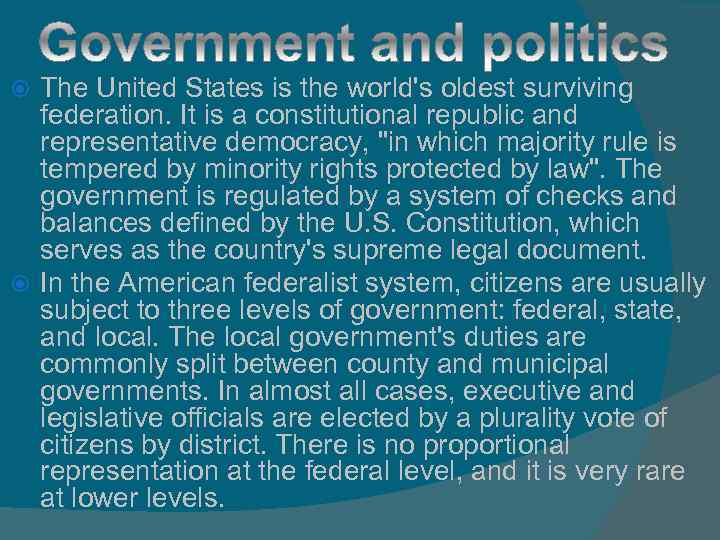 The United States is the world's oldest surviving federation. It is a constitutional republic and representative democracy, "in which majority rule is tempered by minority rights protected by law". The government is regulated by a system of checks and balances defined by the U. S. Constitution, which serves as the country's supreme legal document. In the American federalist system, citizens are usually subject to three levels of government: federal, state, and local. The local government's duties are commonly split between county and municipal governments. In almost all cases, executive and legislative officials are elected by a plurality vote of citizens by district. There is no proportional representation at the federal level, and it is very rare at lower levels.
The United States is the world's oldest surviving federation. It is a constitutional republic and representative democracy, "in which majority rule is tempered by minority rights protected by law". The government is regulated by a system of checks and balances defined by the U. S. Constitution, which serves as the country's supreme legal document. In the American federalist system, citizens are usually subject to three levels of government: federal, state, and local. The local government's duties are commonly split between county and municipal governments. In almost all cases, executive and legislative officials are elected by a plurality vote of citizens by district. There is no proportional representation at the federal level, and it is very rare at lower levels.
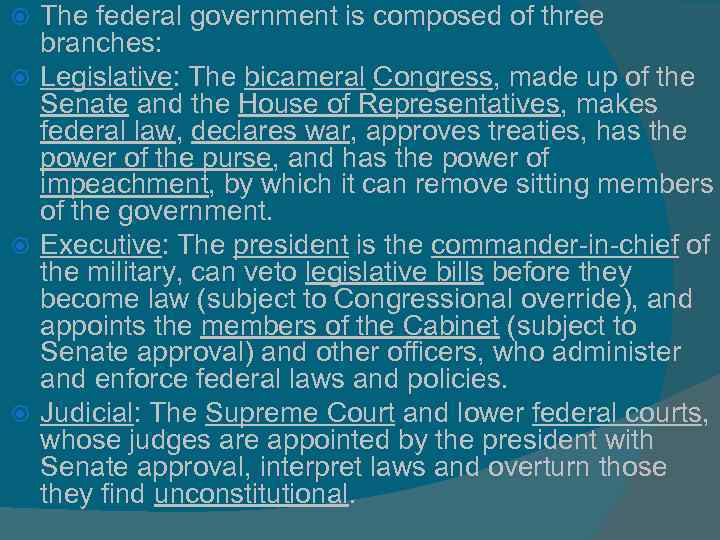 The federal government is composed of three branches: Legislative: The bicameral Congress, made up of the Senate and the House of Representatives, makes federal law, declares war, approves treaties, has the power of the purse, and has the power of impeachment, by which it can remove sitting members of the government. Executive: The president is the commander-in-chief of the military, can veto legislative bills before they become law (subject to Congressional override), and appoints the members of the Cabinet (subject to Senate approval) and other officers, who administer and enforce federal laws and policies. Judicial: The Supreme Court and lower federal courts, whose judges are appointed by the president with Senate approval, interpret laws and overturn those they find unconstitutional.
The federal government is composed of three branches: Legislative: The bicameral Congress, made up of the Senate and the House of Representatives, makes federal law, declares war, approves treaties, has the power of the purse, and has the power of impeachment, by which it can remove sitting members of the government. Executive: The president is the commander-in-chief of the military, can veto legislative bills before they become law (subject to Congressional override), and appoints the members of the Cabinet (subject to Senate approval) and other officers, who administer and enforce federal laws and policies. Judicial: The Supreme Court and lower federal courts, whose judges are appointed by the president with Senate approval, interpret laws and overturn those they find unconstitutional.
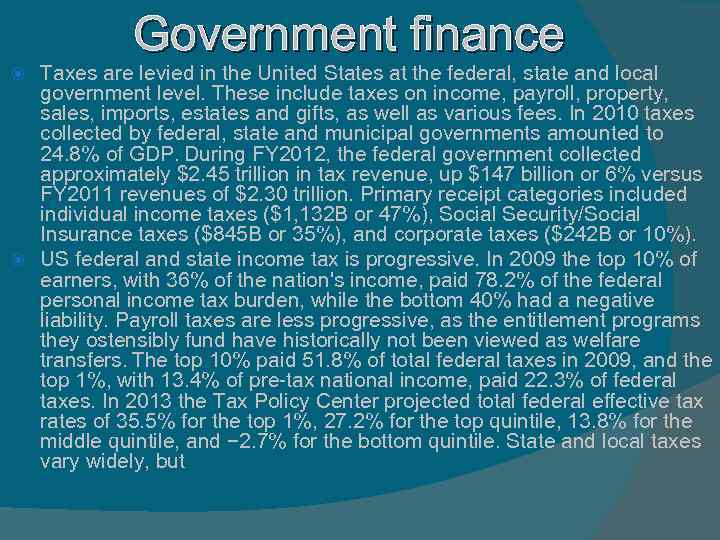 Government finance Taxes are levied in the United States at the federal, state and local government level. These include taxes on income, payroll, property, sales, imports, estates and gifts, as well as various fees. In 2010 taxes collected by federal, state and municipal governments amounted to 24. 8% of GDP. During FY 2012, the federal government collected approximately $2. 45 trillion in tax revenue, up $147 billion or 6% versus FY 2011 revenues of $2. 30 trillion. Primary receipt categories included individual income taxes ($1, 132 B or 47%), Social Security/Social Insurance taxes ($845 B or 35%), and corporate taxes ($242 B or 10%). US federal and state income tax is progressive. In 2009 the top 10% of earners, with 36% of the nation's income, paid 78. 2% of the federal personal income tax burden, while the bottom 40% had a negative liability. Payroll taxes are less progressive, as the entitlement programs they ostensibly fund have historically not been viewed as welfare transfers. The top 10% paid 51. 8% of total federal taxes in 2009, and the top 1%, with 13. 4% of pre-tax national income, paid 22. 3% of federal taxes. In 2013 the Tax Policy Center projected total federal effective tax rates of 35. 5% for the top 1%, 27. 2% for the top quintile, 13. 8% for the middle quintile, and − 2. 7% for the bottom quintile. State and local taxes vary widely, but
Government finance Taxes are levied in the United States at the federal, state and local government level. These include taxes on income, payroll, property, sales, imports, estates and gifts, as well as various fees. In 2010 taxes collected by federal, state and municipal governments amounted to 24. 8% of GDP. During FY 2012, the federal government collected approximately $2. 45 trillion in tax revenue, up $147 billion or 6% versus FY 2011 revenues of $2. 30 trillion. Primary receipt categories included individual income taxes ($1, 132 B or 47%), Social Security/Social Insurance taxes ($845 B or 35%), and corporate taxes ($242 B or 10%). US federal and state income tax is progressive. In 2009 the top 10% of earners, with 36% of the nation's income, paid 78. 2% of the federal personal income tax burden, while the bottom 40% had a negative liability. Payroll taxes are less progressive, as the entitlement programs they ostensibly fund have historically not been viewed as welfare transfers. The top 10% paid 51. 8% of total federal taxes in 2009, and the top 1%, with 13. 4% of pre-tax national income, paid 22. 3% of federal taxes. In 2013 the Tax Policy Center projected total federal effective tax rates of 35. 5% for the top 1%, 27. 2% for the top quintile, 13. 8% for the middle quintile, and − 2. 7% for the bottom quintile. State and local taxes vary widely, but
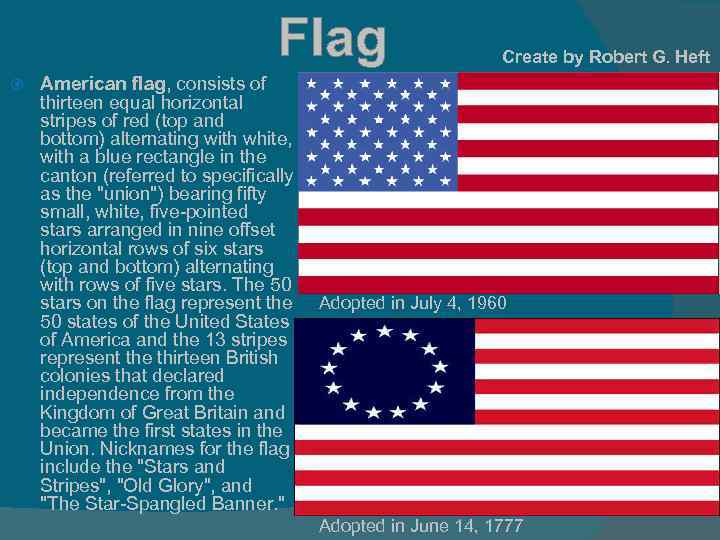 Flag American flag, consists of thirteen equal horizontal stripes of red (top and bottom) alternating with white, with a blue rectangle in the canton (referred to specifically as the "union") bearing fifty small, white, five-pointed stars arranged in nine offset horizontal rows of six stars (top and bottom) alternating with rows of five stars. The 50 stars on the flag represent the 50 states of the United States of America and the 13 stripes represent the thirteen British colonies that declared independence from the Kingdom of Great Britain and became the first states in the Union. Nicknames for the flag include the "Stars and Stripes", "Old Glory", and "The Star-Spangled Banner. " Create by Robert G. Heft Adopted in July 4, 1960 Adopted in June 14, 1777
Flag American flag, consists of thirteen equal horizontal stripes of red (top and bottom) alternating with white, with a blue rectangle in the canton (referred to specifically as the "union") bearing fifty small, white, five-pointed stars arranged in nine offset horizontal rows of six stars (top and bottom) alternating with rows of five stars. The 50 stars on the flag represent the 50 states of the United States of America and the 13 stripes represent the thirteen British colonies that declared independence from the Kingdom of Great Britain and became the first states in the Union. Nicknames for the flag include the "Stars and Stripes", "Old Glory", and "The Star-Spangled Banner. " Create by Robert G. Heft Adopted in July 4, 1960 Adopted in June 14, 1777
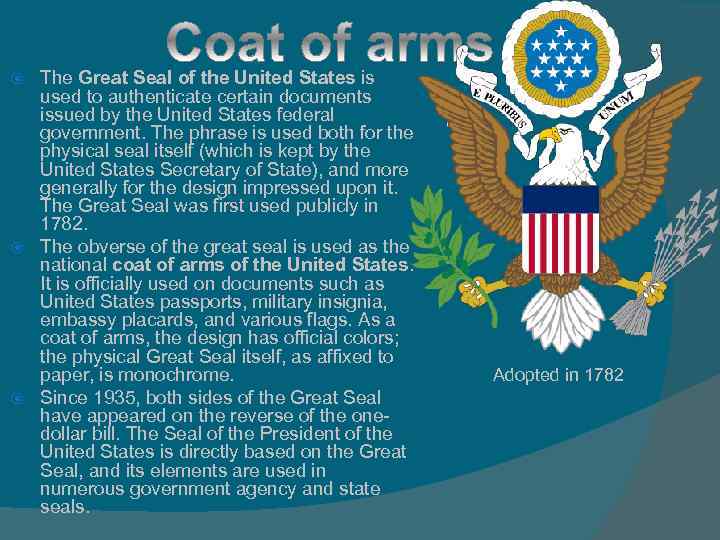 The Great Seal of the United States is used to authenticate certain documents issued by the United States federal government. The phrase is used both for the physical seal itself (which is kept by the United States Secretary of State), and more generally for the design impressed upon it. The Great Seal was first used publicly in 1782. The obverse of the great seal is used as the national coat of arms of the United States. It is officially used on documents such as United States passports, military insignia, embassy placards, and various flags. As a coat of arms, the design has official colors; the physical Great Seal itself, as affixed to paper, is monochrome. Since 1935, both sides of the Great Seal have appeared on the reverse of the onedollar bill. The Seal of the President of the United States is directly based on the Great Seal, and its elements are used in numerous government agency and state seals. Adopted in 1782
The Great Seal of the United States is used to authenticate certain documents issued by the United States federal government. The phrase is used both for the physical seal itself (which is kept by the United States Secretary of State), and more generally for the design impressed upon it. The Great Seal was first used publicly in 1782. The obverse of the great seal is used as the national coat of arms of the United States. It is officially used on documents such as United States passports, military insignia, embassy placards, and various flags. As a coat of arms, the design has official colors; the physical Great Seal itself, as affixed to paper, is monochrome. Since 1935, both sides of the Great Seal have appeared on the reverse of the onedollar bill. The Seal of the President of the United States is directly based on the Great Seal, and its elements are used in numerous government agency and state seals. Adopted in 1782
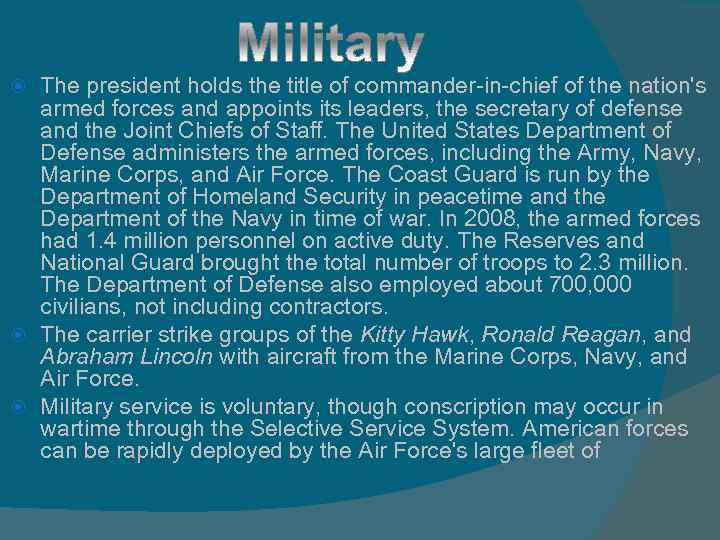 The president holds the title of commander-in-chief of the nation's armed forces and appoints its leaders, the secretary of defense and the Joint Chiefs of Staff. The United States Department of Defense administers the armed forces, including the Army, Navy, Marine Corps, and Air Force. The Coast Guard is run by the Department of Homeland Security in peacetime and the Department of the Navy in time of war. In 2008, the armed forces had 1. 4 million personnel on active duty. The Reserves and National Guard brought the total number of troops to 2. 3 million. The Department of Defense also employed about 700, 000 civilians, not including contractors. The carrier strike groups of the Kitty Hawk, Ronald Reagan, and Abraham Lincoln with aircraft from the Marine Corps, Navy, and Air Force. Military service is voluntary, though conscription may occur in wartime through the Selective Service System. American forces can be rapidly deployed by the Air Force's large fleet of
The president holds the title of commander-in-chief of the nation's armed forces and appoints its leaders, the secretary of defense and the Joint Chiefs of Staff. The United States Department of Defense administers the armed forces, including the Army, Navy, Marine Corps, and Air Force. The Coast Guard is run by the Department of Homeland Security in peacetime and the Department of the Navy in time of war. In 2008, the armed forces had 1. 4 million personnel on active duty. The Reserves and National Guard brought the total number of troops to 2. 3 million. The Department of Defense also employed about 700, 000 civilians, not including contractors. The carrier strike groups of the Kitty Hawk, Ronald Reagan, and Abraham Lincoln with aircraft from the Marine Corps, Navy, and Air Force. Military service is voluntary, though conscription may occur in wartime through the Selective Service System. American forces can be rapidly deployed by the Air Force's large fleet of
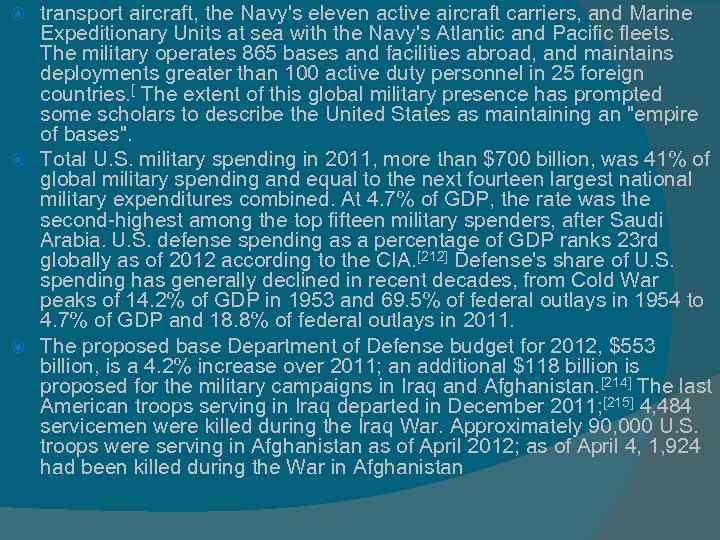 transport aircraft, the Navy's eleven active aircraft carriers, and Marine Expeditionary Units at sea with the Navy's Atlantic and Pacific fleets. The military operates 865 bases and facilities abroad, and maintains deployments greater than 100 active duty personnel in 25 foreign countries. [ The extent of this global military presence has prompted some scholars to describe the United States as maintaining an "empire of bases". Total U. S. military spending in 2011, more than $700 billion, was 41% of global military spending and equal to the next fourteen largest national military expenditures combined. At 4. 7% of GDP, the rate was the second-highest among the top fifteen military spenders, after Saudi Arabia. U. S. defense spending as a percentage of GDP ranks 23 rd globally as of 2012 according to the CIA. [212] Defense's share of U. S. spending has generally declined in recent decades, from Cold War peaks of 14. 2% of GDP in 1953 and 69. 5% of federal outlays in 1954 to 4. 7% of GDP and 18. 8% of federal outlays in 2011. The proposed base Department of Defense budget for 2012, $553 billion, is a 4. 2% increase over 2011; an additional $118 billion is proposed for the military campaigns in Iraq and Afghanistan. [214] The last American troops serving in Iraq departed in December 2011; [215] 4, 484 servicemen were killed during the Iraq War. Approximately 90, 000 U. S. troops were serving in Afghanistan as of April 2012; as of April 4, 1, 924 had been killed during the War in Afghanistan
transport aircraft, the Navy's eleven active aircraft carriers, and Marine Expeditionary Units at sea with the Navy's Atlantic and Pacific fleets. The military operates 865 bases and facilities abroad, and maintains deployments greater than 100 active duty personnel in 25 foreign countries. [ The extent of this global military presence has prompted some scholars to describe the United States as maintaining an "empire of bases". Total U. S. military spending in 2011, more than $700 billion, was 41% of global military spending and equal to the next fourteen largest national military expenditures combined. At 4. 7% of GDP, the rate was the second-highest among the top fifteen military spenders, after Saudi Arabia. U. S. defense spending as a percentage of GDP ranks 23 rd globally as of 2012 according to the CIA. [212] Defense's share of U. S. spending has generally declined in recent decades, from Cold War peaks of 14. 2% of GDP in 1953 and 69. 5% of federal outlays in 1954 to 4. 7% of GDP and 18. 8% of federal outlays in 2011. The proposed base Department of Defense budget for 2012, $553 billion, is a 4. 2% increase over 2011; an additional $118 billion is proposed for the military campaigns in Iraq and Afghanistan. [214] The last American troops serving in Iraq departed in December 2011; [215] 4, 484 servicemen were killed during the Iraq War. Approximately 90, 000 U. S. troops were serving in Afghanistan as of April 2012; as of April 4, 1, 924 had been killed during the War in Afghanistan
 Poject made by: Makatsaria Papuna Levkovich Bogdan
Poject made by: Makatsaria Papuna Levkovich Bogdan


